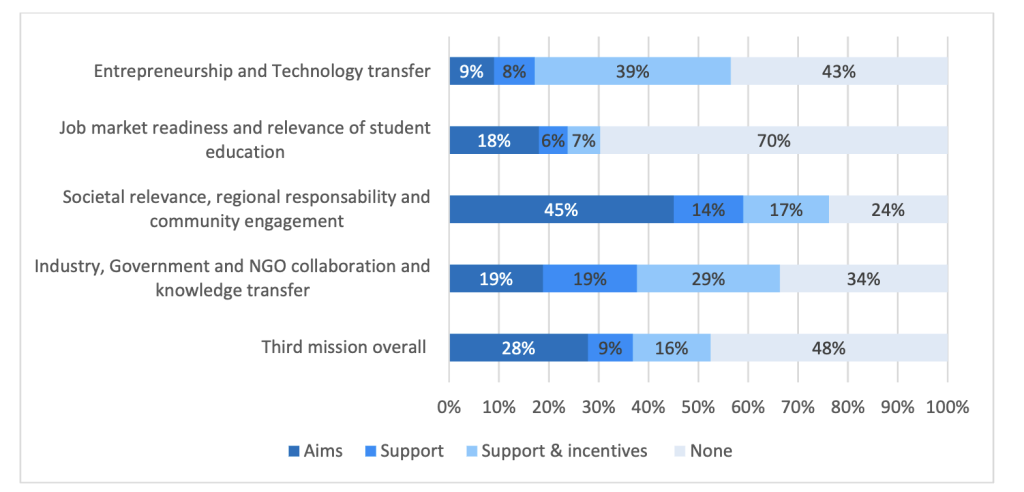Open Science in Higher Education Institutions (HEIs) is a policy priority for the European Commission and a standard method of working under its research and innovation funding programmes. The European Commission argues that Open Science improves the quality, efficiency, and responsiveness of research and innovation.
Our study relies on data collected as a document study of 122 European HEIs, of which three out of four HEIs included Open Science in their main strategic documents and policies. The study evaluates the Open Science policies and strategies within the HEIs. The documents were analysed with respect to the above understanding of what Open Science includes, while also remaining open to new elements. As a result of this process, the analysis was subdivided into the categories Open Science, Open Access and Open Data.
The graph below shows how the HEIs work with Open Science; whether they have an approach based on establishing aims, on supporting work on Open Science, or if their approach is a combination of supporting work on Open Science while also having incentives to work with Open Science.

The analyses showed that ‘Open Access’ is the policy area most of the HEIs include in their strategic documents, with only 27% having no content related to Open Access. A substantial portion (63%) have implemented support structures and incentives concerning Open Access, primarily consisting of infrastructure, dedicated units, and rules and requirements. In more substantial terms, the infrastructure related to Open Science predominantly includes in-house Open Access repositories and/or in-house Open Access journals. The dedicated units primarily refer to library staff responsible for maintaining the repositories and Open Access journals. In some cases, these library staff members are also responsible for training researchers in the use of the repositories and journals, as well as Open Access publishing in general. Rules and requirements primarily refer to institutional expectations that prescribe researchers to publish Open Access. In some cases, it is specified whether green or golden path publishing is expected. A total of 7% of the HEIs mention support for Open Access initiatives, which mostly consist of policy targets and recommendations and suggestions. The policy targets primarily concern intentions to increase the amount of Open Access publishing and intentions to develop Open Access infrastructure, such as those mentioned above. Recommendations and suggestions are similar to the rules and requirements mentioned above; however, they are not mandatory for researchers to follow. Finally, a marginal percentage (2%) solely communicate Open science policy aims. Many of these refer to national or international networks or expressed aims. However, most of these also have either support measures or support and incentives in their initiatives, placing them under another policy category. The expressed aims primarily concern more abstract and diffuse ideas related to Open Access, for example, considerations concerning Open Access as an ethical standard or Open Access as a general societal benefit. The references primarily relate to either Horizon Europe at the international level or Open Access networks at the national level.
The second most frequently mentioned policy area is ‘Open Science’, where 50% of the HEIs include some type of content in their strategic documents. In comparison to Open Access, the Open Science policy area is mainly aspirational, with 26% of the HEIs mentioning aims as their Open Science approach, whereas half do not include any Open Science in their strategic documents. As with Open Access, most of the expressed aims concern general statements about Open Science or simply state that Open Science is a priority at the respective HEI. A total of 17% of the HEIs’ approaches consist of support and incentives regarding Open Science, where ‘infrastructure’ is frequently mentioned. The infrastructure mentioned primarily refers to online platforms with Open Science guidelines or e-infrastructure to support Open Science. A total of 7% of the HEIs can be categorized as having ‘support’ for Open Science. Again, support mainly revolves around Policy Targets mentioning intentions to either develop or improve the HEI’s Open Science infrastructure.
The least prevalent policy area in the sample of European HEIs was ‘Open Data’, with 59% of the HEIs not mentioning any sort of Open Data content. However, 23% of the HEIs have initiatives that include support and incentives in relation to Open Data, which again primarily consists of infrastructure. Like Open Access, the Open Data infrastructure mentioned is predominantly external or internal repositories, but with an explicit mention of data sharing and not just data publishing. Still, Open Data remains more aspirational than Open Access, as 14% of the HEIs have initiatives that consist of aims, predominantly references to international or national networks, or expressed aims. The majority of those HEIs that reference networks refer to FAIR-data. Like the other sub-policy areas, the expressed aims generally either mention abstract statements about Open Data or that Open Data is a priority without further specificity. A total of 4% of the HEIs have Open Data initiatives that revolve around support, again mostly in terms of policy targets. Like the two other sub-policy areas, the policy targets mainly concern the development or improvement of Open Data repositories and increasing the amount of shared data.